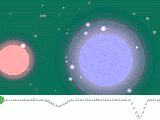31 Crateris
31 Crateris is a binary star system in the constellation Corvus. Varying between apparent magnitudes 5.19 and 5.23 over 1.48 days, it has the variable star designation of TY Corvi.[2] It is actually a remote system with a hot blue-white star of spectral type B1.5V and a companion about which little is known. The two stars orbit each other every 2.9631 days. The primary is possibly a blue straggler of the Hyades group.[4] The primary is around 15.5 times as massive as the Sun and 52,262 times as luminous.[3]
| Observation data Epoch J2000.0 Equinox J2000.0 | |
|---|---|
| Constellation | Corvus |
| Right ascension | 12h 00m 51.16003s[1] |
| Declination | −19° 39′ 32.3350″[1] |
| Apparent magnitude (V) | 5.19-5.23[2] |
| Characteristics | |
| Spectral type | B1.5V + ? |
| Variable type | Eclipsing binary |
| Astrometry | |
| Radial velocity (Rv) | 1.7 ± 2 km/s |
| Proper motion (μ) | RA: -16.17 ± 0.41 mas/yr Dec.: 6.81 ± 0.29 mas/yr |
| Parallax (π) | 1.03 ± 0.53 mas |
| Distance | approx. 3,000 ly (approx. 1,000 pc) |
| Details | |
| Mass | 15.5[3] M☉ |
| Luminosity | 52,262[3] L☉ |
| Temperature | 23700[3] K |
| Other designations | |
| Database references | |
| SIMBAD | data |
British astronomer John Flamsteed numbered the stars in an expanded constellation he termed Hydra and Crater, which included the stars of Hydra immediately below the Cup. Published in 1712, this was not followed by later astronomers. 31 Crateris ended up in the constellation Corvus after formal boundaries were set in 1922.[5]

On 27 March 1974, the Mariner 10 mission detected emissions in the far ultraviolet. These were initially thought to be Mercury's moon before the source was shown to be 31 Crateris.[7][6]
References
- basic query result — Object query : HD 104337
- Watson, Christopher (4 January 2010). "TY Corvi". The International Variable Star Index. American Association of Variable Star Observers. Retrieved 11 June 2015.
- Hohle, M. M.; Neuhäuser, R.; Schutz, B. F. (April 2010), "Masses and luminosities of O- and B-type stars and red supergiants", Astronomische Nachrichten, 331 (4): 349, arXiv:1003.2335, Bibcode:2010AN....331..349H, doi:10.1002/asna.200911355, S2CID 111387483
- Eggleton, P. P.; Tokovinin, A. A. (September 2008), "A catalogue of multiplicity among bright stellar systems", Monthly Notices of the Royal Astronomical Society, 389 (2): 869–879, arXiv:0806.2878, Bibcode:2008MNRAS.389..869E, doi:10.1111/j.1365-2966.2008.13596.x, S2CID 14878976.
- Wagman, Morton (2003). Lost Stars: Lost, Missing and Troublesome Stars from the Catalogues of Johannes Bayer, Nicholas Louis de Lacaille, John Flamsteed, and Sundry Others. Blacksburg, Virginia: The McDonald & Woodward Publishing Company. pp. 390–91. ISBN 978-0-939923-78-6.
- Stratford, R.L. (1980). "31 Crateris reexamined". The Observatory. 100: 168. Bibcode:1980Obs...100..168S.
- Moore, Patrick (2000). The Data Book of Astronomy. CRC Press. p. 79. ISBN 9781420033441.